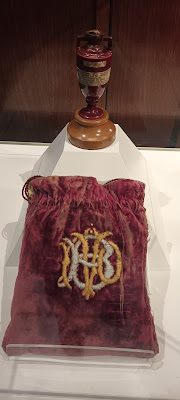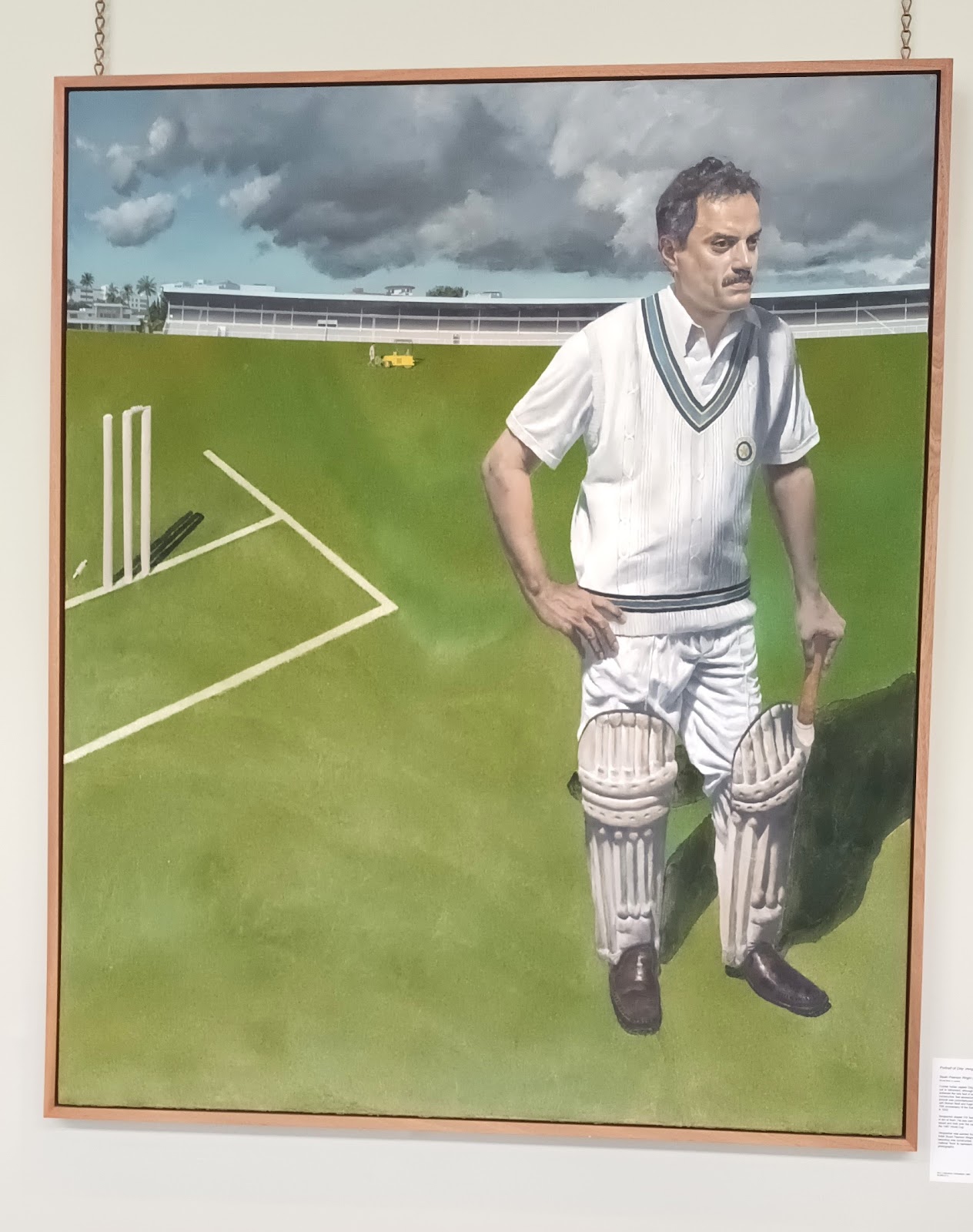(Links to all parts of the series are at the end of this post.)
June 12, Wednesday
It was scheduled for 3:30 p.m., and we were required to arrive at least 30 minutes in advance for mandatory security checks.
With very little time to spare, we hurried from the BBC to Lord's. The journey, although not far, took about half an hour by tube.
W.G. GRACE
We arrived at the Grace Gate, located on St. John's Wood Road. It's named after W.G. Grace, one of the earliest legends of the game. We first went to the museum and then to the Pavilion.
We were accompanied by a guide who was very knowledgeable, articulate and engaging in his description of various facets of the game and its players.
W.G. Grace's influence on cricket was immense. He was an all-rounder who played first-class cricket for an astonishing 43 years (1865–1908), participating in nearly 870 matches.
In 1873, Grace became the first player to score over 1,000 runs and take more than 100 wickets in a single season. He was also the first cricketer to score a triple century, achieving this milestone in 1876.
Beyond cricket, Grace was a qualified physician, having graduated from Bristol Medical School in 1879. He balanced dual careers and was commonly known by the nickname "The Doctor".
THOMAS LORD
Being at Lord's was surreal, a name so familiar from childhood, thanks to the Test matches we followed religiously on the radio.
The ground is named after Thomas Lord, who established it in 1787. Lord's is home to the Marylebone Cricket Club (MCC) and is also the venue for Middlesex County Cricket Club matches.
The stadium currently holds around 31,000 spectators after multiple renovations. This capacity pales in comparison to the Narendra Modi Stadium in Ahmedabad, Gujarat, which seats 132,000 — making it the largest stadium in the world.
MARYLEBONE CRICKET CLUB
Lord's is owned by the MCC, founded in the same year that Lord's was established, 1787.
The club was started by a group of cricketers led by Thomas Lord. It originally played at Dorset Fields in Marylebone, London, where they hosted their first match between Middlesex and Essex. In 1814, the club moved to its current location.
In 1788, that is one year after its founding, the MCC formulated the laws of the game. While the International Cricket Council now oversees the laws, MCC retains copyright over them.
The club is so exclusive that the waiting list to become a member is said to be around 30 years!
THE MUSEUM
Our tour began with a visit to the Lord's Cricket Museum, one of the oldest sports museums in the world.
The museum boasts an incredible collection of memorabilia, including the original Ashes Urn and the first Men's and Women's Cricket World Cup trophies. There are detailed exhibits on the evolution of cricket and profiles of legendary players.
There is a letter written on the 22nd of February 1933 by the secretary of the MCC to England's captain Douglas Jardine. It was soon after the infamous 'Bodyline series' in which English players, on the instructions of Jardine, bowled aiming at the body of the Australian batsmen in an intimidating manner.When a delivery struck Australian captain Bill Woodfull, there was a fear of a riot. The situation was exacerbated by Jardine's character, who was perceived as rude and supercilious.
However, the MCC supported Jardine. The letter talks of his "wonderful captaincy" and says:
The crowds seem to have behaved abominably, and from all accounts, you have shown most wonderful restraint, and I am sure you will continue to do so until the end because, as you are reported to have said in one of your speeches, 'the least said, the soonest mended'.
The museum also displays cricket kits worn by greats such as Victor Trumper, Jack Hobbs, Don Bradman, and Shane Warne.
There are also scorebooks of some of the matches. One of them is the first match played by All India XI on the tour of England in 1911 against Oxford University from June 1 to 3.THE ASHES URN
I was really delighted to see the original Ashes Urn. It is the most sacred and prized exhibit.
Our guide provided a fascinating history of the Ashes, and we couldn't resist taking photos beside it.
The history of the Ashes dates back to the 1882 Test series when Australia defeated England at The Oval — the first time Australia won a Test match on English soil.
The Sporting Times published a mock obituary stating:
In Affectionate Remembrance of English Cricket, which died at the Oval on 29th August, 1882. Deeply lamented by a large circle of sorrowing friends and acquaintances. R.I.P. N.B.— The body will be cremated and the ashes taken to Australia.
 |
| The urn |
After Bligh died in 1927, the urn was given to the MCC, where it has been on display ever since.
On the urn, a six-line verse is pasted. This is the fourth verse of a song-lyric published in the Melbourne Punch on 1 February 1883:
When Ivo goes back with the urn, the urn;
Studds, Steel, Read and Tylecote return, return;
The welkin will ring loud,
The great crowd will feel proud,
Seeing Barlow and Bates with the urn, the urn;
And the rest coming home with the urn.
While the original urn is inside a glass case, there is a small replica that one can hold, have a close look at, and take pictures with.
STUFFED SPARROW
 |
| The stuffed sparrow |
July 3, 1936, a ball delivered by Jahangir Khan of Cambridge University to T.N. Pearce of MCC struck a sparrow killing it instantly. It was stuffed and mounted on the very ball that killed it.
THE PAVILION
After visiting the museum, we moved on to the Pavilion, which houses the players' dining room, besides the Long Room, often described as "the most evocative four walls in world cricket".
 |
| Dilip Vengsarkar |
 |
| Kapil Dev |
There is a strict dress code here. Men and women have to be formally attired.
DRESSING ROOM
The dressing rooms for the home and away teams are located above the Long Room. So the players have to walk a long and winding distance to the field and back. There are stories of players getting lost on the way to the field and back!
 |
| The ground |
The Pavilion also features separate dressing rooms for the home and away teams, each with its own balcony for players to view the match.
The entire Lord's Tour lasted over an hour and a half.
WRAPPING UP THE DAY
After the tour, we had dinner at one of the nearby restaurants and then took the tube back to Wanstead.
It was a long and exhausting day. The day had started with a London city tour, followed by a visit to the BBC, and then concluded with this unforgettable Lord's experience.
A tiring but truly eventful and memorable day.
(To be continued)
Links to all the posts in the series
01 - Departure (June 05, Wednesday)
02 - Dockwray Square, Tynemouth (June 06, Thursday)
03 - Cresswell Pele Tower (June 07, Friday)
04 - Howick Hall Gardens & Arboretum (June 07, Friday)
05 - Boulmer Beach, Zamorins (June 07, Friday)
06 - Beamish Museum (June 08, Saturday)
07 - The Holy Island of Lindisfarne (June 09, Sunday)
08 - Linhope Spout Waterfall (June 10, Monday)
09 - London, Wanstead (June 11, Tuesday)
10 - London City (June 12, Tuesday)
11 - BBC (June 12, Tuesday)
12 - Lord's Cricket Stadium and Museum (June 12, Tuesday)




